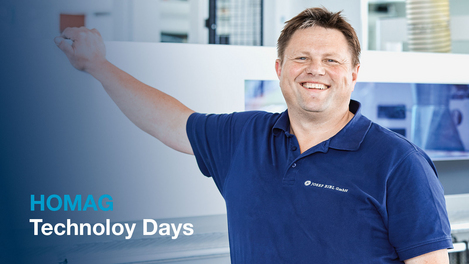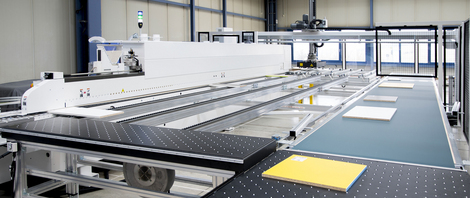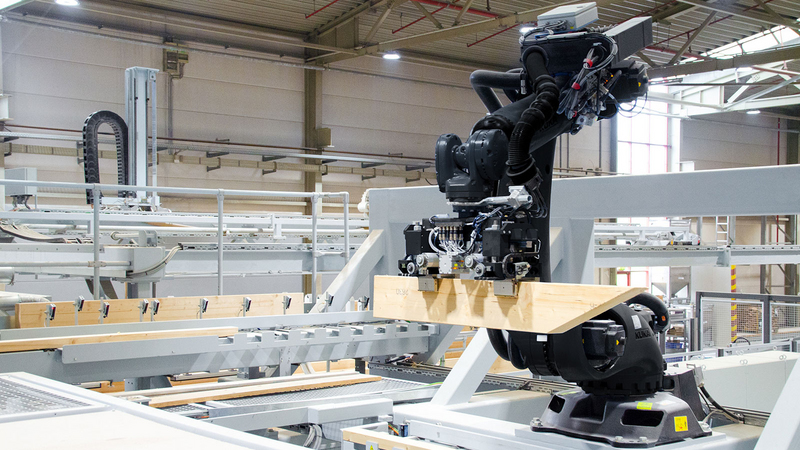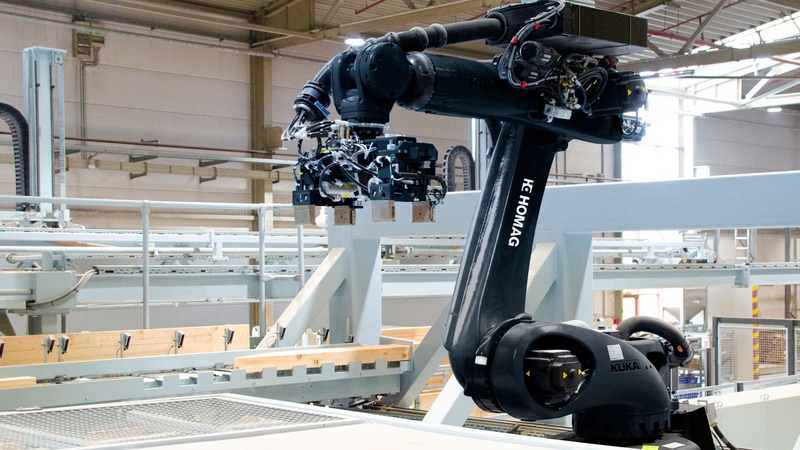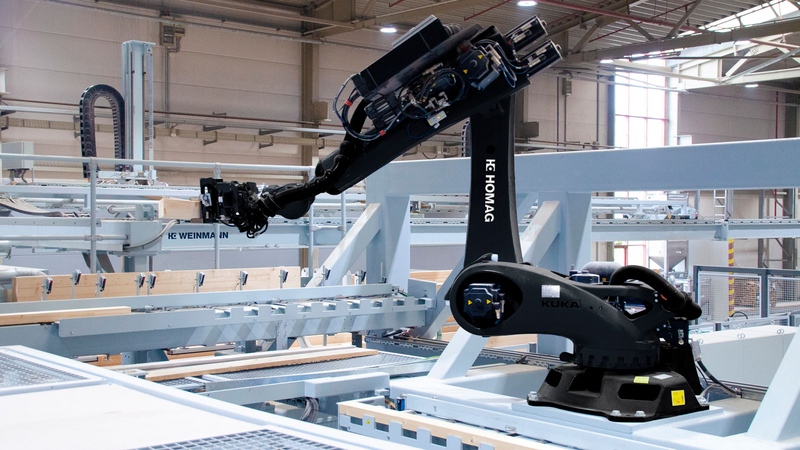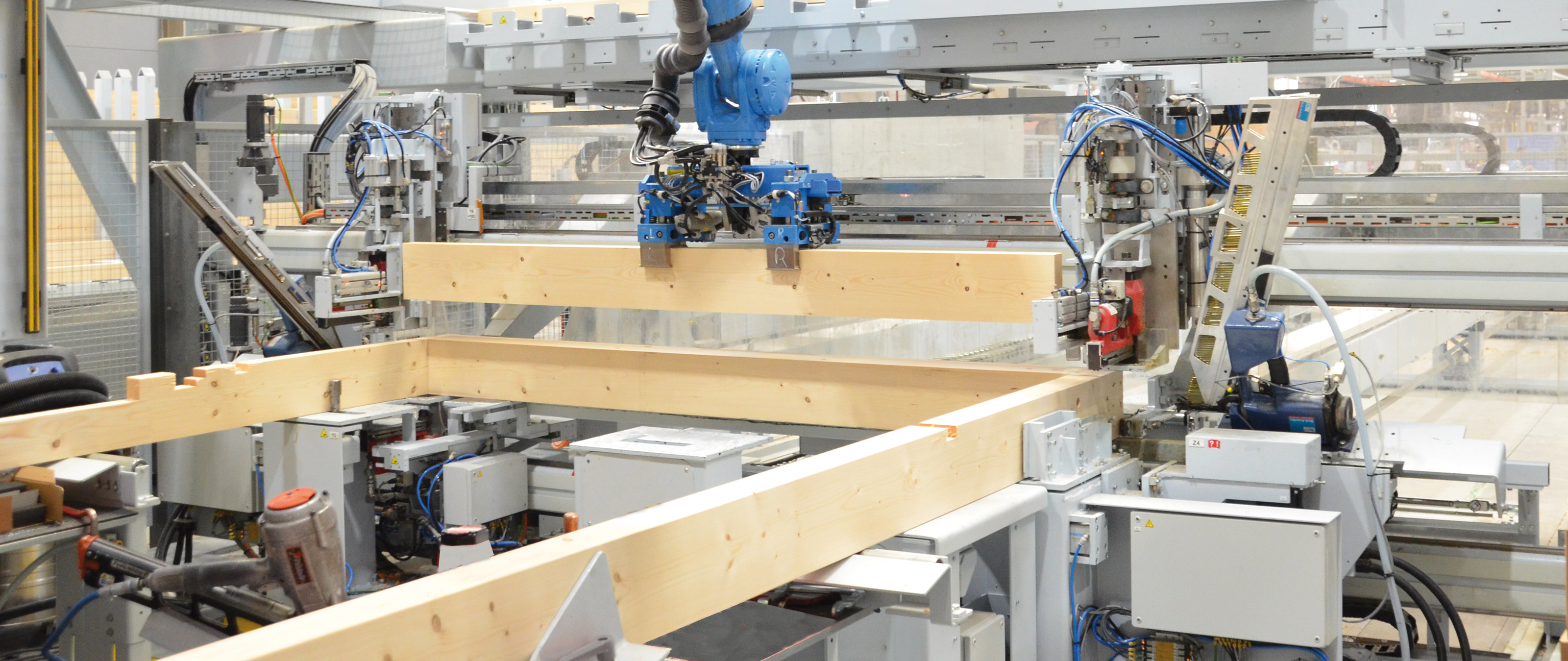Robotic technology offers opportunities for timber house construction
Today, a number of different fields have seen an increase in the use of robotic technology. This technology is also opening up new opportunities for house construction. But in which industrial fields is robotic technology being used today? What are the advantages and limitations of using robotics? And what should customers consider when choosing the right robot?
An article from the specialist magazine HOLZBAUER spezial, 01/2019, www.wirholzbauer.ch.
The term "robot" is of Slavic origin and is derived from the word "robota", which means "compulsory service" or even "forced labor." This definition comes very close to that of today's industrial robots, as strictly speaking, a robot is also subjected to a fixed kind of forced labor. Our current understanding of robots—as devices that are obedient to human beings and perform all kinds of hard labor—is shaped by science fiction narratives.
Robots in timber house construction
Robots have long been established in the furniture industry. And for some time now, their use has also been successfully implemented in timber house construction. Frame work construction has already been asserted as a standard application for timber house manufacturers. In this type of application, the robot is integrated into a frame work station and is used to insert various studs into the frame work. During the insertion process, the robot distinguishes between special and standard studs. In addition to different pick-up stations, varying insertion procedures are also used. Depending on whether plates, studs or spandrel beams are being handled, the studs are inserted crosswise, lengthwise or diagonally. The six-axis robot operates within a radius of 3500 millimeters, picking up both standard studs and special studs with a length of 780 to 3500 millimeters. Cross-sections ranging from 40 on 100 millimeters to 160 on 250 millimeters can be achieved, with longer top plates and bottom plates being fed directly from attached beam processing systems.
Stud weights of up to 75 kilograms
The work is parameterized, which offers considerably more flexibility compared to teaching the robot. With parameterization, only the extreme dimensions have to be known — everything in between can be calculated by the robot itself. The cross-sections and timber lengths serve as the relevant parameters. In this standard application, a classic six-axis robot is used. This robot can perform up to six cycles per minute, but in other applications, up to 15 cycles are possible. The ergonomics of these physically demanding activities is one of the key reasons why manufacturers opt for a robot. What's more, the robot can handle stud weights of up to 75 kilograms.
This application uses a clamping gripper, which clamps down on the studs from above. The gripper is equipped with an air motor and includes a travel measuring system for faster intake. The gripper also contains self-locking spindles, which do not lose hold of the wood even if there is a loss in pressure. Pressure sensors are integrated into the gripper for exchanging signals when the gripper is in a clamped state. The gripper uses a sensor to detect whether it is impossible to carry a beam, and reacts to this accordingly.
Versatile use
Robots present the ideal solution for work steps performed in sequence, as they work quickly and accurately and take the strain off employees. Once instructed, a robot can be used in material transport and warehouse logistics for tasks such as sorting and storing sheathing materials. The production line could then include a robot that removes the panels from storage or the transport system and places them on the elements. This sort of thinking is already happening in the prefabricated construction industry, and first steps in this direction have already been taken.
Thanks to the flexibility of the industrial robot, it is feasible to imagine using it at other points in production, for example in the application of glue or plaster, for positioning electrical sockets or for inserting electrical or heating systems. Robotic technology offers a variety of options and is sure to have a significant impact on wood work in future.
The right robot
When designing a robotics application—both within the wood-processing industry as well as outside of wood work—the field of application must first be considered. This includes asking the following questions:
- Does the robot form part of a processing application?
- Which tasks should the robot be responsible for (handling, processing, sorting, etc.)?
- What does the robot's environment look like (available stations, spatial provisions, etc.)?
- For sorting tasks, both the formation of stacks as well as the zero edges of the stack need to be clarified.
- How does the range of parts need to be moved or manipulated (gripper, suction device, cross rails, etc.)?
- What type of material is used? Is this material porous or strongly adhesive, or does it have sensitive surfaces?
- What level of performance needs to be achieved with the robot?
- How many different cycles need to be run?
- Through which interface are parts identified (RFID, QR code, stack list down to manual inputs, etc.)?
Industrial use
A robot that paints doors in the automotive industry one day will not readily handle timber panels, studs or beams the next. Today, the demand for specific types of robots is huge, with robot manufacturers developing their products to be strongly tailored to the various tasks of users. Firstly, there are parallel kinematics—such as with gantry robots—and secondly, there are serial kinematics — such as with six-axis robots or palletizing robots. The serial kinematics are the most commonly used in the wood-processing industry.
The industrial robot often has to compete with a gantry. While a gantry offers benefits such as lower space requirements and higher cycle output, robots often provide significant advantages when it comes to availability, room height, reusability and working area. In recent years, the use of robots in the industry has been steadily on the increase for a number of reasons. In addition to the monetary benefits, robots also offer a range of technical advantages.
In this regard, three aspects are particularly significant:
- Robots now boast an extremely high level of availability. At 99.9%, robots beat the conventional gantry solution by a mile.
- Their long service life is just one important aspect why the use of industrial robots is so versatile today. Very little effort is required when using robots continuously on a 24/7 basis, 365 days a year.
- Another significant reason why operators opt for robots is the low operating cost resulting from the low-maintenance operation of these robots. This very argument speaks volumes about the advantages of using robots in the wood-processing industry. Thanks to the closed kinematics, it is almost impossible for inaccessible places to become contaminated. The use of high-quality components is yet another reason why robots can be operated with such little maintenance. Equipped with economical electric motors and a low power supply, robots can be used with very little energy consumption.
Additional arguments for the use of robots include the shortage of skilled workers, the demand for a level of quality that is as consistently high as possible, and the ability to adapt the investment to further applications. Combined with the relatively low procurement costs, the major advantages offered by a robot lead to a short return on investment (ROI).

